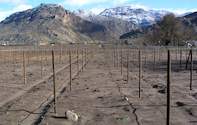The expected lifespan of a vineyard is over twenty years so it is important to ask the right experts for advice. The following aspects should be considered before a new vineyard can be established:

The current cultivars planted on the farm: which cultivars and how many are currently grown?
The intended tonnage that the new vineyard should produce.
Is the ripening time of the new cultivar in conflict with that of the existing cultivars and crops?
What other agricultural crops are currently being cultivated?
The availability of water.
The degree of mechanization applied.
Soil information of the specific area as well as the suitability of the vineyard cultivation environment in terms of location and slope.
Handling of different soil types, drainage (if necessary) as well as the chemical and microbiological correction of the soil is taken into account.
Cultivar application and the type of wine that will be produced and for which market it will be produced. Cultivar and clone choices must be considered as well as suitable rootstocks adapted to the soil type.
Further attention should be given to the aspects surrounding the location of the rootstocks: planting width, rootstock spacing and direction, length of the vine rows as well as the trellis system.
The Suitability of the Terrain
You should look at the suitability of the soil - is it suitable for wine grapes or should another crop be considered? Locations that may be exposed to frost damage should be avoided, for example, waterlogged vlei areas and wet or saturated soils should either be avoided or be dried out first.
Certain areas or locations, for example slopes can get too much wind that will make the growth of the vineyard difficult. Slopes may be cooler in the summer than lower lying soils next to a river. Northern slopes in South Africa are warmer and are used for cultivars such as Cabernet, Pinotage, Shiraz and certain white cultivars such as Chenin Blanc and Chardonnay.
Southern slopes however are cooler and cultivars that are well adapted to this are white cultivars such as Sauvignon Blanc and Riesling and red cultivars such as Merlot and Pinot Noir. Fertile river sand can again cause vines to grow very vigorous but the grapes will rot more easily. Red cultivars will also not be intensely red coloured in such conditions.
Row Spacing
The row width is mainly determined by optimal land use, but also by tractors and implements such as the spraying equipment that will be used. The between-row spacing in a vineyard usually range between 2.1 m and 3.0 m but is kept as narrow as possible for optimal soil utilization.
This therefore gives rise to higher production per hectare and consequently also higher income per hectare. The row width depends, however, on which trellis and pruning system are to be used because it determines how wide the canopy will be.
When using harvest machines, particular attention should be given to the road width. These machines are very large and at the ends of the rows the turn space should not be closer than 6-7 m.
Vine Spacing
The distance between the vines is mainly determined by the soil type and cultivar rootstock combination, in other words the the varietal vigour.
The more fertile the soil, the wider the rootstocks are planted apart. The opposite also applies: the poorer or infertile the soil, the closer the rootstocks are planted to each other.
Row Orientation and Length
The row direction is mostly determined by the area or slope as well as prevailing winds, sun and cultivar. The effect of strong winds and wind direction also plays an important role. Wind blowing in the vineyard can dry the leaves more quickly and limit fungal diseases. It also has a greater cooling effect on the grapes and there is less wind damage.
Strong winds blowing from the sides can damage young shoots early in the season before it is tied to the trellis system. Sun exposure and slopes that cause water erosion are also determining factors in the row orientation when establishing a new vineyard. Consult a viticulturist in this regard to determine the best row orientation for the specific grape cultivar.
The newest trend is to establish longer rows because it is more cost effective and the vehicles take less time turning around. The maximum row length is approximately 250 meters.
By Vinpro